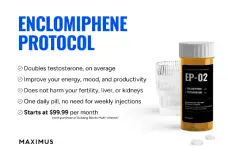In
1978, a newly available
oral testosterone preparation known as
testosterone undecanoate (TU) was investigated as a possible form for male contraception. The study found that regular testosterone use for 10 to 12 weeks causes suppression of sperm production, and even azoospermia, albeit inconsistently [24]. Ever since that study, testosterone has undergone extensive clinical trials as a hormonal method of male contraception and many have found testosterone to be efficacious, reversible and safe with minimal short-term side effects [23].
TESTOSTERONE AS A MALE CONTRACEPTIVE
Unfortunately, the contraceptive effect of testosterone is not reliable. This has been proven in multiple studies, including two by the World Health Organization (WHO) Task Force on Methods for the Regulation of Male Fertility [14,15,25].
These two studies found an azoospermia rate of 64% to 75% in 6 months with testosterone enanthate [6,7]. A sperm concentration of 3 million/mL was used as a threshold for effective suppression of spermatogenesis in this study [14,15]. In a Chinese study of a monthly intramuscular TU injection, an azoospermia rate of 93% to 98% was achieved after 6 months with 1 million/mL as the criteria for effective suppression [25,26].
The different rates of azoospermia can be explained by the variable criteria and by ethnic differences in testosterone response [26,27]. These studies confirm the effectiveness of testosterone as a contraceptive, and provides evidence that men who desire fertility should not be prescribed TRT. Even with this evidence, testosterone has not been approved by the USA Food and Drug Administration (FDA) for use as a contraceptive. In 2011, a phase II study for a combined TU/norethisterone enanthate formulation ended prematurely because of higher than anticipated adverse effects including mood changes (such as depression), increased libido, acne and weight gain [27,28].
FORMULATIONS OF TESTOSTERONE REPLACEMENT THERAPY
In terms of the contraceptive effect of the different formulations of testosterone,
most research has shown that transdermal and intramuscular testosterone seem to be the strongest contraceptive formulations. The WHO and Chinese studies used testosterone enanthate and TU, respectively.
The topical formulations of testosterone have variable contraceptive effects. T
he testosterone patch was shown to be an ineffective contraceptive [41] while the gel had mixed results [42,43].
However, the sample size for most of these studies are not large enough to truly assess the extent to which fecundity is affected. More research needs to be done to evaluate the contraceptive effect of the various formulations of testosterone.
USING TESTOSTERONE IN THE TREATMENT OF HYPOGONADISM IN MEN WHO DESIRE FERTILITY
Considering that there is abundant evidence demonstrating that TRT significantly decreases sperm production, it is important that clinicians consider the evidenced risks of male infertility before starting patients on TRT.
It can be surprising to patients that testosterone can suppress fertility, in contrary to its stimulatory effects on libido and erectile function. The patient’s desire for fertility must be discussed in depth and established prior to initiating testosterone. The discussion must also include future thoughts on fertility. This will allow the physician to manage the timing of hypogonadism treatment, essentially balancing the alleviation of hypogonadal symptoms with the patient’s desires for fertility.
This could also open discussion about cryopreservation of sperm as an option for the patient to preserve fertility further down the line.
Regardless, the recovery of spermatogenesis is unclear for patients on chronic TRT. Physicians should take caution when treating hypogonadism in men who desire future fertility, but also acknowledge the reversible azoospermia seen in controlled studies [51].
Adjunctive hCG and clomiphene can be used with TRT to maintain testicular size and intra-testicular testosterone concentrations [52]. Referral to a reproductive urologist should be considered in a male with low testosterone interested in fertility.
CONCLUSIONS
Testosterone therapy is a contraceptive, albeit a poor one. Men of reproductive age with low testosterone should be counseled on the adverse effects of TRT on fertility.
Obtaining a semen analysis and possible cryopreservation of sperm should be offered if TRT is prescribed to men interested in preserving fertility. Options such as clomiphene citrate and hCG along with a referral to a reproductive urologist should be considered to naturally increase testosterone levels in those men with low testosterone who want to avoid TRT.













